
African-American Plants Earth
Day - April 22, 2013
This year's East Orange Earth Day celebration
theme (at least from the East Orange Tea
Party), is the merging of cultures and plants from Europe,
Africa, and Native Americans. We have chosen Watermelons from
Africa and Crookneck Squash, native to America.
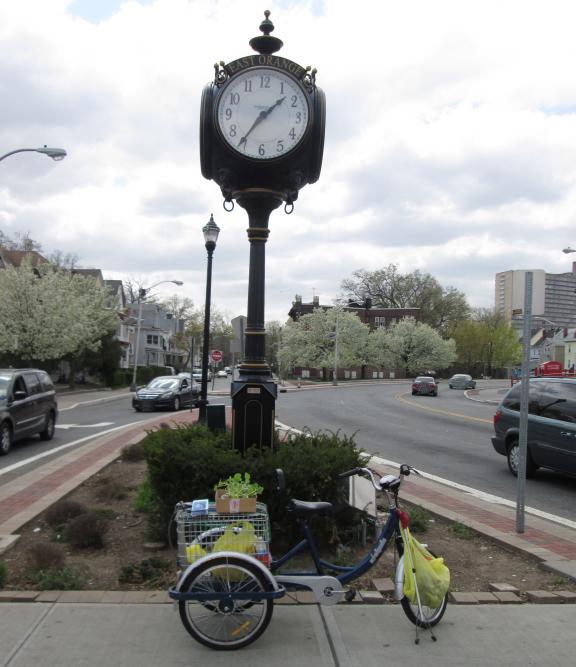
I arrived at the Clock Garden at 1:00 PM, and
after a half hour or so of work, I stopped for a break and took
these photos. I had collected two bags of litter from just this
one small space. No one offered to help, so I gave away no
brochures and no watermelon or crookneck squash plants. I'll give
those away later to high school students and others who are
starting home gardens. We have a few such gardeners in our
neighborhood trying to fight back against city blight and neglect.
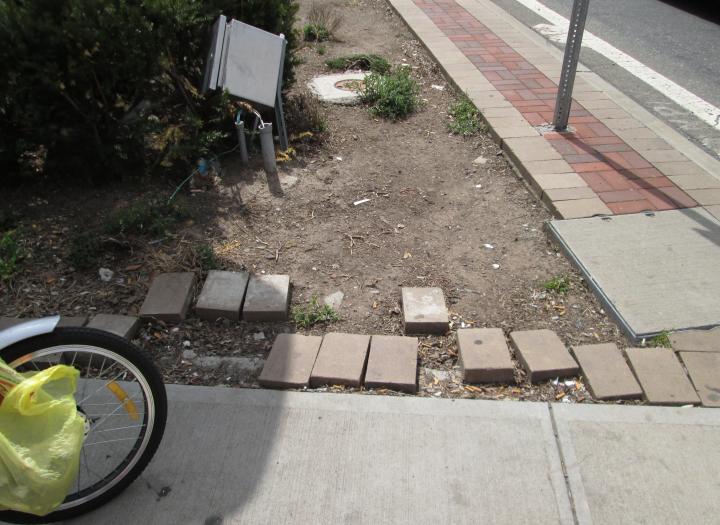
In addition to all the litter, I found that many
of the the paving blocks had been moved out of place from the
edge of the garden (before photo above). I didn't have
the proper tools to scrape out the ground and tamp them down, but
I did manage to get them back into place, although I don't bend
over as well as I used to. The city needs to send out someone to
do a proper job, and one of the paving blocks is completely
missing, so whomever gets the assignment should bring along an
extra block. There is a damaged electrical box showing in the
photo, and that should be taken care of by an electrician.
There is a Star Ledger Newspaper vendor that
stands on this spot in the mornings, and I am guessing that much
of the debris is left by that person. The city needs to make a
deal with the Star Ledger to get the vendor to clean up the spot
during waiting times instead of adding to the litter. That person
could also report things like the damaged paving blocks and
electrical box since no one from the city seems to notice these
things.
One last thing- the Chrysanthemum
plants (Mums) that looked so beautiful last Autumn, are now
covered with scraggly dried stems, but waiting underneath are
green sprouts on next year's flowers. The brush needs to be
cleared away so the flowers can re-emerge and be ready for late
August, early September to show up all over again. This is true
not just in the Clock Garden, but in the medians all up and down
Central Avenue.
======================================
African Watermelons
Watermelon is thought to have originated in
southern Africa, where it is found growing wild. It reaches
maximum genetic diversity there, with sweet, bland and bitter
forms. In the 19th century, Alphonse de Candolle claimed the
watermelon was indigenous to tropical Africa. Evidence of its
cultivation in the Nile Valley was found from the second
millennium BC. Watermelon seeds have been found at Twelfth
Dynasty sites and in the tomb of Pharaoh Tutankhamun. Watermelon
is also mentioned in the Bible as a food eaten by the ancient
Israelites while they were in bondage in Egypt. African farmers
have long used the watermelon to help them survive droughts and
live in dry, arid regions of that continent.
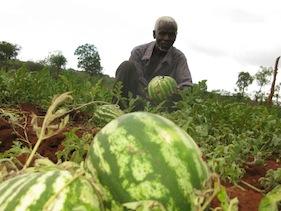
African farmer Geoffrey Ndungu earns a
living growing watermelons on his dry land during a recent
drought. Credit: Isaiah Esipisu/IPS
By the 10th century, watermelons were being
cultivated in China, which is today the world's single largest
watermelon producer. By the 13th century, Muslim invaders had
introduced the fruit to Europe. According to John Mariani's Dictionary
of American Food and Drink, "watermelon" made its
first appearance as a word in an English dictionary in 1615.
Watermelons were being grown by Native Americans
in the 16th century. Early French explorers found the fruit being
cultivated in the Mississippi Valley. Many sources list the
watermelon as being introduced in Massachusetts as early as 1629.
Southern food historian John Egerton has said he believes African
slaves helped introduce the watermelon to the United States.
Tips for growing your Earth Day watermelon
seedlings:
Watermelons grow best in well-drained soil with a pH of
6.0 to 6.8.
Form planting mounds about 3 in. tall and 12 in. to 18 in.
wide to improve drainage.
To direct seed with your Heritage seeds from this year's
watermelons next year, plant two seeds 1 in. deep in each mound
and thin to one plant after they have at least two leaves.
Improve growth by controlling weeds with cultivation,
which also helps aerate roots
If youre wondering what youd have to
push out of your garden to make room for watermelons, dont
despair. All you need to do is train your watermelons to climb.
As the vines, which should be about two feet apart, begin to run,
send them up a sturdy trellis. You will need to tie the runners
to the trellis, since watermelons are not natural climbers.
Once the plants set fruit, support the burgeoning melons with
slings, which can be made with cheesecloth, nylon stockings, or
old T-shirts. If the sling completely covers the fruit, it
provides protection from insects. In addition to saving space,
trellising improves air circulation and helps prevent watermelon
plant disease.
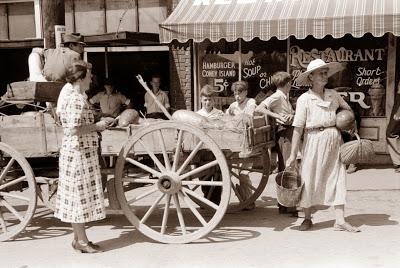
Watermelon-wagon in Kentucky, c. 1940.
How to tell when the watermelons are ready for
harvest:
Although determining the optimum maturity of a
watermelon can be difficult, the plant provides clues. First,
inspect the curly tendril near where the watermelon attaches at
the stem. It should be dead or brown.
Second, turn the melon on its side and inspect the belly. The
underside of the watermelon should be creamy-white.
Third, thump. A ripe melon should deliver a deep, low-pitched
sound. This has always been a popular way to detect ripeness, but
I have found it takes a lot of experience to truly tell the right
sound.
And finally, if youll notice, watermelons have a shiny,
bright green color on the outside as they grow. When the
watermelon matures, this coloring will dull.

Sixth Street Farmer's Market in Richmond, Virginia, c. 1900
Native American Crookneck Squash
The English word "squash" derives from
askutasquash (a green thing eaten raw), a word from the
Narragansett language, which was documented by Roger Williams,
the founder of Rhode Island, in his 1643 publication A Key
Into the Language of America.
Northeastern Native American tribes grew pumpkins, yellow
crooknecks, patty pans, Boston marrows (perhaps the oldest squash
in America still sold), and turbans. Southern tribes raised
winter crooknecks, cushaws, and green and white striped sweet
potato squashes. Native Americans roasted or boiled the squashes
and pumpkins and preserved the flesh as conserves in syrup. They
also ate the young shoots, leaves, flowers, and seeds.
Our Summer Crookneck Squash of today, named as a variety in seed
catalogues as early as 1828, appears to be the same as a squash
described by Champlain in 1605 that he saw growing in Native
American gardens inside and outside their villages.
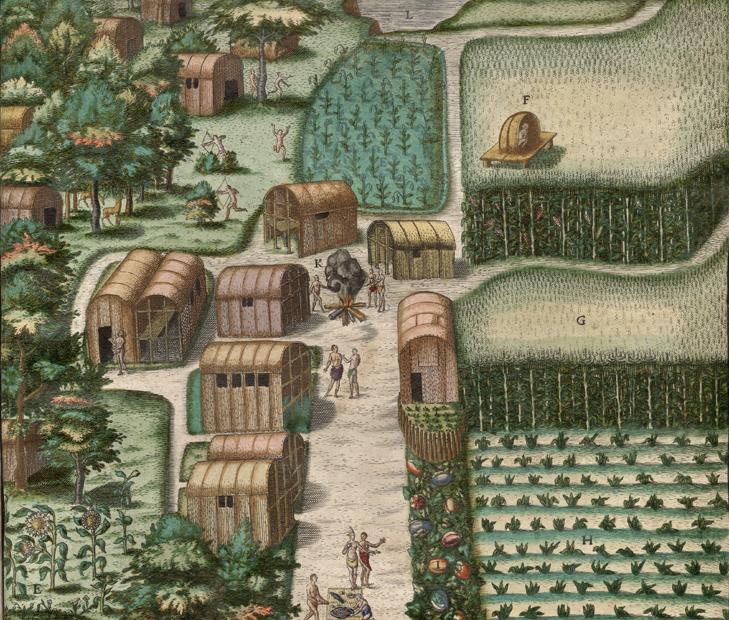
This engraving by Theodor de Bry depicting the Native
American town of Secota was first published in 1588.
It was made from an even earlier watercolor drawing,"Indian Village of Secoton", by John
White, created circa 1585-1586.
Secotan was probably located on the south side of the Pamlico
River, perhaps near the present day Bonnerton, North Carolina
Yellow crookneck squash takes 58 days to mature
and is commonly harvested when it attains a length of six
inches.Yellow crookneck squash can be baked, steamed and can be
stir-fried. It can also be used in soups and needs to be consumed
about a week or so after picking. It is mainly cooked as a
vegetable dish and can be mixed with other vegetables. Harvest
the seeds before cooking the squash and you will be able to grow
them to get squash again next year.
This is perhaps as good a place as any to point
out that neither squash nor pumpkin will cross-pollinate either
watermelon or muskmelon. Growing squash or pumpkins near melons
will not affect the quality of the melons, despite the persistent
belief that it will make the melons taste like pumpkins. Bad
weather, poor soil, or disease may make melons taste bad, but it
is not due to crossing of squash or pumpkins with melons.
The seedlings we are giving away on Earth Day
are grown from Heritage seeds from Heirloom
Solutions. For those who don't know what a Heritage seed is,
you need to know that most of the fruits and vegetables you buy
in modern stores are hybrids. They either have no seeds, or their
seeds will not germinate and grow. Heritage seeds are taken from
non-hybrid sources. If you grow a watermelon or squash from our
heritage seedlings, save and dry out the seeds (before cooking in
the case of the squash!) and almost every one of them will
germinate and grow into a new plant next year, and on into the
future.
This is our brochure for 2013.
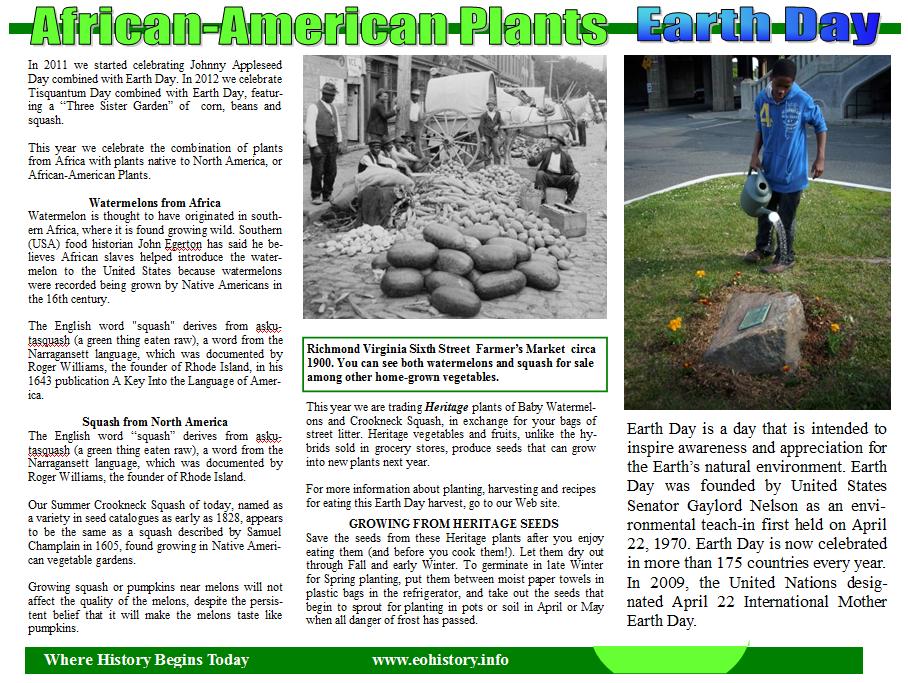
Click on the Brochure to
get a printable pdf file.




